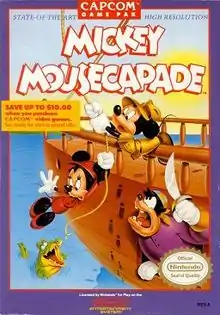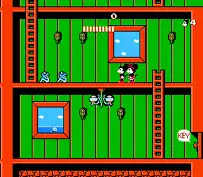Mickey Mousecapade
Mickey Mousecapade, released in Japan as Mickey Mouse: Fushigi no Kuni no Daibouken (ミッキーマウス 不思議の国の大冒険, "Mickey Mouse: Adventures in Wonderland"), is a platform game developed by Hudson Soft and published by Capcom originally in 1987 for the Family Computer (Famicom) in Japan.[1] Capcom released the game for the Nintendo Entertainment System (NES) in the United States.
| Mickey Mousecapade | |
|---|---|
 North American cover art | |
| Developer(s) | Hudson Soft |
| Publisher(s) | |
| Composer(s) | Takeaki Kunimoto |
| Platform(s) | Family Computer/NES |
| Release | |
| Genre(s) | Platformer |
| Mode(s) | Single-player |
The character of Mickey Mouse attempts to save a young girl who happens to be Alice from Alice in Wonderland. Minnie Mouse follows Mickey around and occasionally gets kidnapped. Various villains from Disney cartoons make an appearance as bosses.
Premise

Mickey and Minnie are traveling through the Fun House, the Ocean, the Forest, the Pirate Ship, and the Castle trying to rescue someone mentioned only as "a friend" in ads and the instruction manual. In the game's ending, the friend is revealed to be Alice from Alice in Wonderland. In the Japanese version, Alice is prominently featured on the box art and instruction manual.
The title screen of the American version refers to the game by its Japanese title, which is simply Mickey Mouse.
Regional differences
While the gameplay, soundtrack and premise to rescue Alice is the same, there are a considerable number of differences between Capcom's American release and Hudson's original game for the Famicom, especially when it comes to the use of Disney characters.
Both versions make use of Disney villains for bosses but not one of them is present in both versions. For example, the Cheshire Cat from Alice in Wonderland is the first boss in the Japanese version, but in the American version he was replaced by Witch Hazel. Many Disney characters who appear as regular foes in the Japanese version were also replaced in the American version by other Disney villains. Unlike other Mickey Mouse video games, Pete is not the final boss; instead, that role is played by Maleficent in the American version of the game and by the Queen of Hearts on the Japanese version. Pete does however appear as the fourth boss on the American version.
The Japanese version was based, first and foremost, on the film Alice in Wonderland and most references about Disney on this version derive from this same movie, although some references to Peter Pan are also made, such as having Captain Hook as the fourth boss in the game. The American localization used a more varied formula, with enemies coming from The Jungle Book, Country Bear Jamboree, Sleeping Beauty and Snow White and the Seven Dwarfs. Some of the items also underwent changes. In the Japanese version, Mickey could refill his life bar by picking up Donald Duck's head but this item was replaced in the American conversion by a simple diamond. Mickey uses throwing stars as a weapon in the American version. However, in Hudson's version, he shoots white balls. The stage names were also edited. For example, the first stage which is known in the American version as the "Fun House" was the "Little House" in the Japanese version.
Reception
Allgame's Skyler Miller described the visuals as serviceable, but the music as overly repetitive.[2] Miller awarded the game two out of five stars. IGN rated it the 86th greatest NES game of all time.[3]
See also
References
- "ミッキーマウス 不思議の国の大冒険 [ファミコン] / ファミ通.com". www.famitsu.com. Retrieved 2018-07-25.
- Miller, Skyler. "Mickey Mousecapade - Review". Allgame. Retrieved June 2, 2013.
- Dunham, Jeremy. "Top 100 NES Games - #86". IGN. Retrieved July 13, 2013.